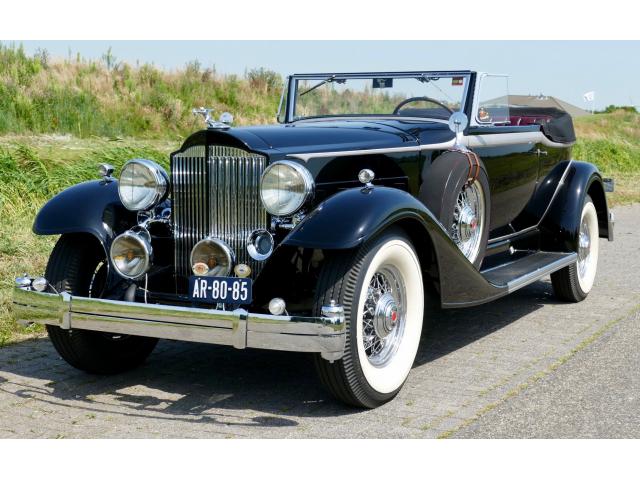1933 Packard Super Eight Convertible Victoria
- Brand: Packard
1933 Packard Super Eight Convertible Victoria
The Packard Motor Company relied on making luxurious cars that were highly refined, fitted with luxurious coachwork, and powered by proven engineering. This belief had placed them among the elite in the auto industry during the early 1900s. As the world entered the Great Depression, the Packard Company was one of the few that managed to survive. In fact, they outsold all of their competitors combined. They had entered the Depression in excellent financial health and they emerged with strong financial footing. But the post depression era had them worried, as the number of potential buyers had dwindled as fortunes were lost. Production had dropped nearly half each year when compared with the previous, from 1929 to 1933. In response to the decline, Packard continued to make improvements each year.
In 1932, Packard introduced their Ninth Series. It featured many improvements which helped segregate it from other automakers in the industry. Improvements included a revised steering geometry which made steering smooth and easy. Braking was equally as easy thanks to the new driver adjustable power assisted braking system. The shifting action and clutch were improved making driving a very enjoyable activity. The drivers workload was eased even further with the spark advance and automatic choke.
By making these changes they attracted a growing segment of buyers and drivers - woman.
The 1933 Packard's were called the Tenth Series cars as the company still refused to adopt the convention of the model year system which called for new cars to be introduced in September or October to coincide with the auto show schedules. The following year, the reluctantly joined with other manufacturers which resulted in a shorted run for the tenth series, lasting just seven months. The new Packard model line was introduced in the fall. Because of the seven month production lifespan of the Tenth Series, very few were produced making them very rare in modern times.
The Tenth Series were given a new X-braced frames, dual coil ignition, and downdraft carburetors. The styling was updated with skirted fenders and a 'V'-shaped radiator shell. The interior featured upgraded trim and a new aircraft inspired dash.
Packard continued to offer three chassis, the Eight, Super Eight, and the Twelve. The Super Eight and Twelve both rested on a wheelbase that measured 142-inches and had a hood that was nearly six-inches longer than the Eight. The fenders were longer as well.
The bodies on the Twelve's and Super Eight were interchangeable, with the Super Eight featuring an eight-cylinder engine while the Twelve featured a twelve cylinder engine. During this time, Packard also produced the Eight, which had a smaller wheelbase size and the eight-cylinder engine. The Super Eight and Twelve differed by interior appointments and engine size. The bodies were constructed of wood and steel.
In 1936 Packard was producing their Fourteenth Series as the number thirteen had been skipped. It is believed that thirteen was not used due to superstitious reasons. The Fourteenth Series was the last year for Bijur lubrication, ride control, a semi-elliptic suspension, mechanical brakes, heavy vibration dampening bumpers and the 384.4 cubic inch straight eight engine. It was also the last year for the option of wire or wood wheels.
In 1936 the fourteenth series received a new radiator which was installed at a five-degree angle. The Super 8 had a new sloped grille with chrome vertical bars which gave the vehicle a unique look and served as thermostatically controlled shutters which opened or closed based on engine heat. The headlight trim, fender styling, and hood vents saw minor changes. A new Delco-Remy ignition system was the new updates for 1936 under the bonnet.
For 1936 there were a total of 1,492 Super Eights constructed.
Descriptions & pictures by conceptcarz & supercars & flickr & juricastricum
| Specification | |
| Production Start | 1933 |
| Country of origin | USA |




































